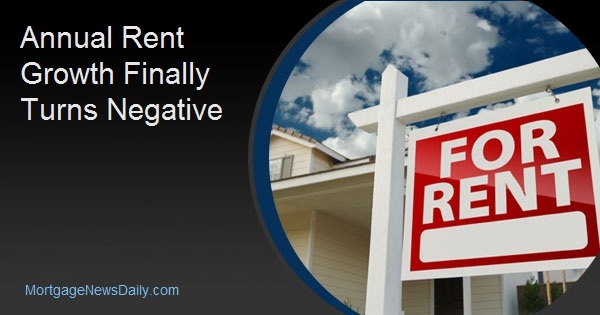Evidence is growing that the housing market is cooling, and Zillow is adding to the pile of proof. However, its contribution points more to a slowdown in the rental market than breaking any news about housing prices.
The company says that annual rent growth has now slowed nationally for eight straight months and turned negative on an annual basis last month for the first time since July 2012. The annual rate of growth in September was -0.2 percent, not only a negative but far from the peak rate of appreciation, 6.6 percent, in July 2015. Still, monthly rent is hardly pocket change. The national median after that 0.2 percent or $36.00 decline, was $1,440.
Rents were lower in 19 of the country's 35 largest housing markets and were unchanged in three more. The largest decline, 2.7 percent, was in Portland, Oregon, followed by Seattle at 2.2 percent. New York and Chicago tied for third at 1.9 percent.
Of course, rents aren't going down everywhere. They were up by 3 percent year-over-year in Riverside California, 1.8 percent in Sacramento, and 1.4 percent in both Tampa and Las Vegas. Thirteen other metro's saw rent hikes as well.
Turning to home prices, Zillow quotes a higher annual increase than most sources, seeing a median price of $222,100 and annual appreciation for the 12 months ending in September of 7.6 percent. They too note some cooling; the August to August increase was 7.8 percent.
Prices were higher year-over-year in all 35 markets, with double digit gains in six of them. San Jose posted a staggering 20.6 percent increase and Las Vegas was up 15.4 percent. Other price leaders were Atlanta, up 12.3 percent, Indianapolis, Dallas/Ft. Worth, and Charlotte, all with increases from 11.0 percent down to 10.5 percent. At the other end of the scale was Washington, D.C. with a tepid appreciation rate of 3.7 percent. The go-go price increases in some places still represent some moderation; for example, the annual appreciation in San Jose back in June was 25.4 percent.
Zillow says the slowing appreciation could benefit home shoppers, but it comes as mortgage rates have seen a sharp increase. These rates have eroded some of the benefits of slower price growth as mortgage payments at the median are increasing more than twice as fast as home values.
The outlook for inventories is looking marginally brighter. While the number of homes for sale shrunk nationwide for the 44th straight month in September, the 1.9 percent annual decrease was the smallest since early 2015. Zillow says about two-thirds of the nation's largest markets are seeing improvements in their inventories, including some recently hot markets. San Jose's inventory was up more than 138 percent and Seattle and San Diego shoppers had nearly half again as many homes to choose from as in September 2017.
Zillow's senior economist Aaron Terrazas says the company's data is another signal that housing is easing toward a more normal and sustainable pace. "With slowing rents and home value growth, searching for a new home should be somewhat less competitive than it was a year ago, giving renters and buyers a bit of breathing room. Housing plays a central role in most people's finances, but for people already in their homes with fixed mortgages, there's minimal spillover. For renters, slower rent growth is welcome news and will put more spending money in their already stretched pockets. The slowdown in new construction is more worrisome for the overall economy: Home building has been a net contributor to economic growth and employment, but rising costs mean that it could shift toward a drag in the future."







